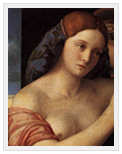
Recent studies have challenged the conventional wisdom that desire must precede sexual arousal; they claim, contrary to this model, that for many women, desire is not the cause of lovemaking, but rather, its result, particularly in long-term relationships.
This approach is outlined in an article by Michael Castleman* that appeared Psychology Today in 2009 (Desire In Women: Does It Lead To Sex? Or Result From It?).
* * *
The conventional wisdom is that desire precedes sexual arousal. This works for most men. Men are often coiled springs of desire and easily aroused. Men often describe their libido as a drive similar to hunger or thirst. Twentieth-century sexologists assumed that women’s libido was, if not identical, then similar — and that if women didn’t feel desire, then something was wrong.
Using this reasoning, something would be wrong with one-third of women. That’s what University of Chicago researchers found in a landmark 1999 survey. Only 15 percent of male respondents said they felt little or no desire — and alcohol, stress, diabetes, heart disease, and disabilities were clear predictors. But 30 percent of women respondents said they lacked libido, usually for no apparent reason. The Chicago researchers concluded that low libido — or “hypoactive desire disorder” — was disturbingly prevalent among women.
The drug companies agree. They are busily trying to develop pills to boost women’s desire.
But what if desire does not precede arousal?
That’s what University of British Columbia psychiatrist Rosemary Basson, M.D., discovered in interviews with hundreds of women. Contrary to the conventional model, for many women, desire is not the cause of lovemaking, but rather, its result. “Women,” Basson explains, “often begin sexual experiences feeling sexually neutral.” But as things heat up, so do they, and they eventually experience desire.
If a substantial proportion of women don’t experience desire before becoming sexual, then drugs and supplements that try to pique it before the fact put the cart before the horse and may be a waste of money.
This new concept of women’s desire explains why Viagra doesn’t work for most women, and why sex-boosting herb blends help only some. These products do not affect desire. They increase blood flow into the genitals. Men are always aware of increased genital blood flow. It’s hard to miss an erection, and it’s only a short step from erection to desire.
But a good deal of research shows that women are often unaware of genital blood engorgement. “Many women have little awareness of it,” Basson notes. Even when women are aware it, they often deny feeling aroused.
If so many women don’t experience male-style desire before sex, then why do they make love? According to Basson, for reasons that affirm their relationships but are not inherently sexual, wanting to please their lover, feel intimate, prevent strife, or make up after it. Basson’s model supports an old saying about the difference between men and women: Men become intimate to have sex. Women have sex to become intimate.
If many women experience desire as the result of lovemaking, then the critical question becomes not how to ignite their desire before sex, but rather: What kind of lovemaking arouses women sufficiently to enable them to experience desire?
According to leading sexologists, the type of sex that fuels desire is leisurely, playful, sensual lovemaking based on whole-body massage that includes the genitals but is not limited to them. This is the lovestyle that many surveys show women prefer, but often don’t get. One of women’s main sexual complaints is that men are non-sensual — too rushed, and too focused on the breasts, genitals, and a quick plunge into intercourse.
Given Basson’s view of women’s desire, this complaint makes perfect sense. Rushed lovemaking doesn’t give women the time many need to become aroused enough to experience desire.
Ironically, the sexual style that allows women to experience desire is the same one sex therapists recommend for men who want to cure premature ejaculation and erectile dysfunction. In other words, a sensual, massage-based approach to lovemaking is a win-win. Men’s penises act the way men want. And women are much more likely to experience desire, and become the enthusiastic lovers that both they and their lovers would like them to be.
* * *
* San Francisco journalist and novelist Michael Castleman has written about sexuality and sex research for several decades. He has answered more than 10,000 sex questions for Playboy, other magazines, WebMD, and other sites.
His latest sexuality book is Great Sex: The Man’s Guide to Whole-Body Sensuality (Rodale, 2008), nominated as Best Sexuality Book of the Year by the American Association of Sex Educators, Counselors, and Therapists. (He has also written several murder mysteries set in San Francisco that deal, in part, with the city’s rich history.)